Fatigue management software helps companies reduce fatigue-related risks and promote employee well-being. By analyzing work schedules, shift patterns, and employee data, these tools identify potential fatigue hazards and provide alerts for intervention.
Key benefits include:
- Improved workplace safety by reducing fatigue-related incidents
- Increased productivity with well-rested employees
- Compliance with regulations on work hours and rest periods
- Data-driven decisions for fatigue risk management
- Prioritizing employee health and a culture of safety
Top 7 Fatigue Management Software Tools
- Workforce Management with SAFTE-FAST - Trapeze Group
- UKG for Fatigue Management
- FAST Scheduling Software - Fatigue Science
- CIRCADIAN® Software
- Fatigue Management - Employee Scheduling Tool - Indeavor
- PRISM Fatigue Management Systems - Predictive Safety
- Fatigue Science: Readi | Predictive Fatigue Management Software
| Tool | Key Features |
|---|---|
| Workforce Management with SAFTE-FAST | Schedule creation, rule compliance, reporting & analytics |
| UKG for Fatigue Management | Fatigue pattern tracking, incident reduction, employee well-being |
| FAST Scheduling Software | Incident analysis, risk identification, graphic displays |
| CIRCADIAN® Software | Schedule compliance analyzer, fatigue risk analyzer, incident causation testing |
| Fatigue Management - Indeavor | Automated schedule creation, fatigue risk alerts, regulatory reporting |
| PRISM Fatigue Management Systems | Predictive scheduling algorithm, real-time notifications, attendance system integration |
| Fatigue Science: Readi | Fatigue predictions, real-time notifications, detailed reporting |
When selecting a fatigue management software, consider factors like ease of use, customization options, reporting and analytics capabilities, and integration with existing HR systems.
1. Workforce Management with SAFTE-FAST - Trapeze Group

Reducing Fatigue Risks for Transit Workers
Trapeze Group's Workforce Management with SAFTE-FAST helps transit agencies minimize fatigue-related risks for operators. By predicting employee alertness levels, this software enables agencies to evaluate safety risks and ensure compliance with work hour regulations. It's particularly useful for fixed route, paratransit, light rail, and commuter rail operations.
User-Friendly Scheduling and Compliance
The system integrates with existing systems, allowing real-time data analysis and schedule optimization. Schedulers can create and modify schedules manually through an intuitive interface. Alerts notify them of any rule violations, ensuring schedules follow regulations for work hours, breaks, and rest periods.
Detailed Reporting and Analytics
| Feature | Benefit |
|---|---|
| Fatigue Risk Tracking | Identify problem areas and make data-driven decisions |
| Incident Reduction | Improve workplace safety by reducing fatigue-related incidents |
| Employee Well-being | Promote personnel health by managing fatigue levels |
The reporting and analytics capabilities provide insights into fatigue risk levels, enabling agencies to take proactive measures for safety and employee well-being.
2. UKG for Fatigue Management
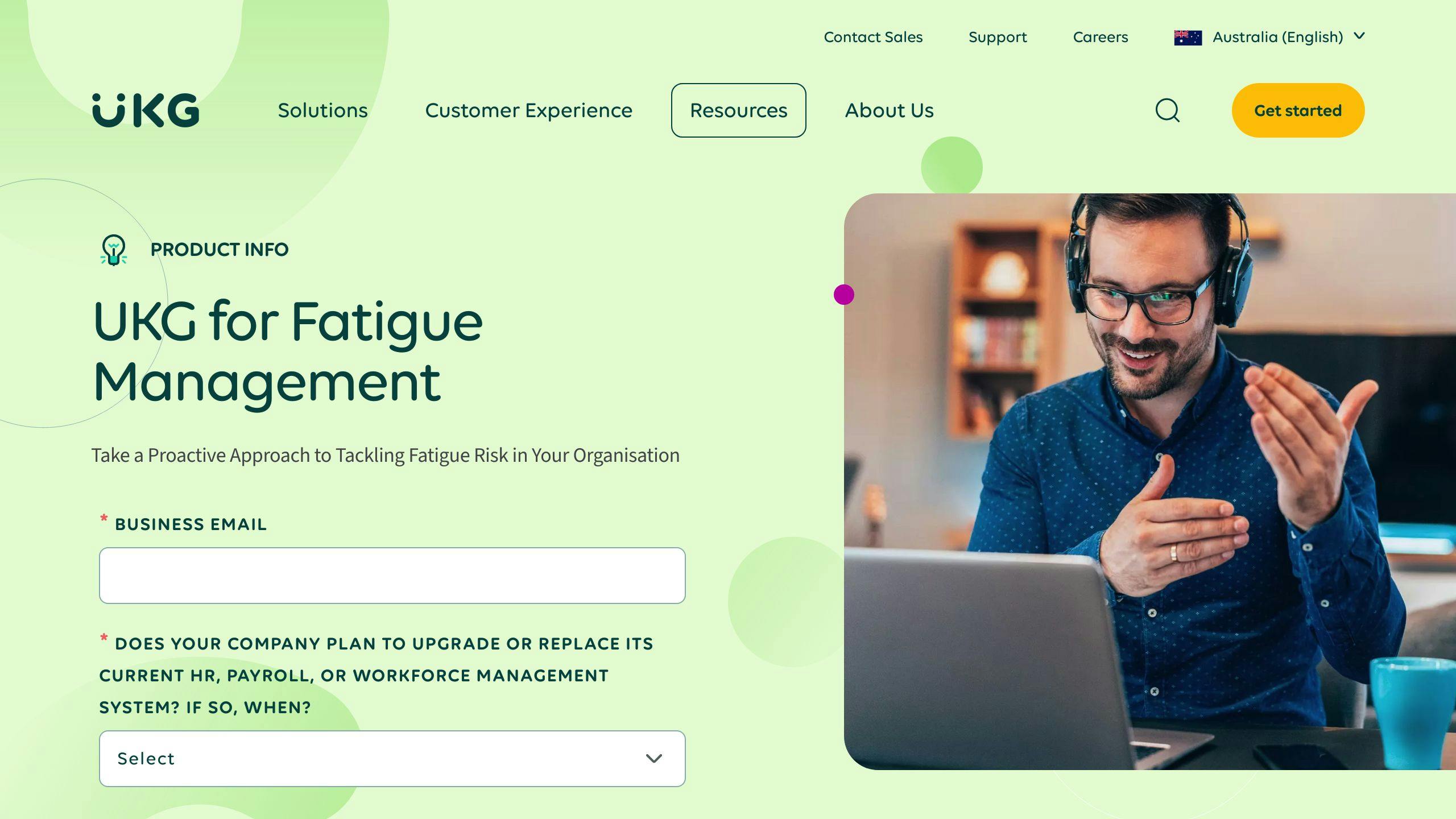
Identifying and Reducing Fatigue Risks
UKG's fatigue management solution helps organizations detect and mitigate the causes of employee fatigue. By analyzing fatigue data, businesses can recognize patterns that contribute to tiredness and make scheduling adjustments to support well-rested, productive staff. This is crucial in industries where fatigue can have severe consequences, such as healthcare.
Easy Integration and Use
The solution integrates with existing systems, enabling real-time data analysis and schedule optimization. Schedulers can create and modify schedules through a user-friendly interface, easily identifying and addressing potential fatigue risks. The system automatically flags problematic patterns, allowing businesses to take proactive measures to reduce fatigue.
Detailed Reporting and Analytics
| Feature | Benefit |
|---|---|
| Fatigue Pattern Tracking | Gain insights into fatigue risk levels |
| Incident Reduction | Improve workplace safety by reducing fatigue-related incidents |
| Employee Well-being | Support personnel health by managing fatigue levels |
UKG's solution provides metrics on potentially fatigue-inducing shift patterns, such as regular overnight and consecutive shifts. The reporting and analytics capabilities enable data-driven decisions to enhance workplace safety and employee well-being.
3. FAST Scheduling Software - Fatigue Science
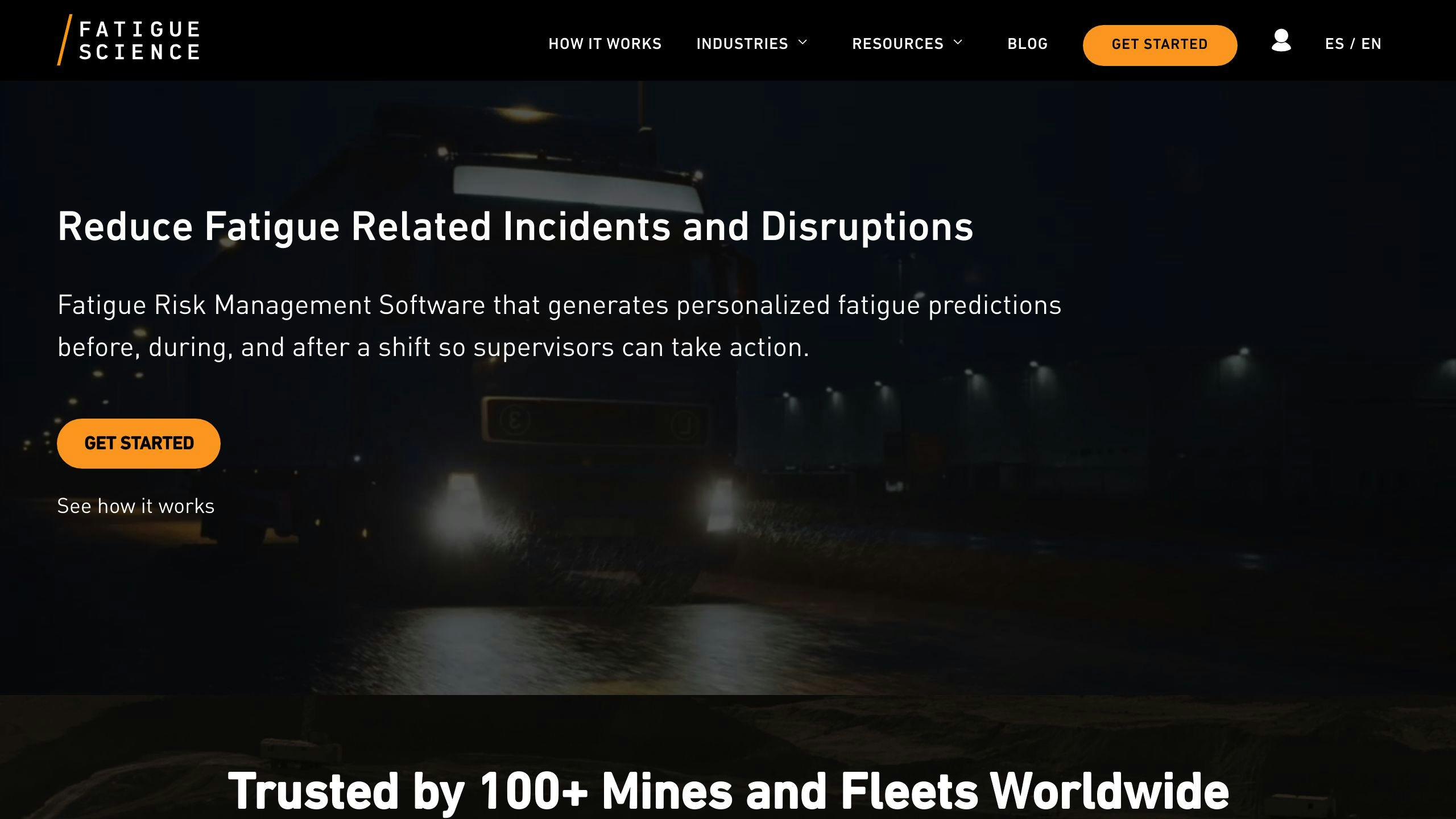
FAST Scheduling software from Fatigue Science helps organizations manage employee fatigue risks. It's designed for industries, the military, and sports teams.
Improving Safety
The software lets organizations analyze incidents to see if fatigue played a role. This helps identify risks and develop strategies to make the workplace safer.
Easy to Use
FAST Scheduling is a Windows application that integrates with existing scheduling systems. Schedulers can create and modify schedules through a user-friendly interface, spotting potential fatigue risks.
Clear Reporting
The software provides detailed reports and analytics on fatigue risk levels. It shows a graphic display of how work schedules impact employee alertness. This data helps organizations make informed decisions to enhance safety and well-being.
| Feature | Benefit |
|---|---|
| Incident Analysis | Determine if fatigue contributed to an incident |
| Risk Identification | Identify potential fatigue risks |
| Mitigation Strategies | Develop plans to reduce risks |
| Graphic Displays | Visualize the impact of schedules on alertness |
| Data-Driven Decisions | Make informed choices based on fatigue data |
4. CIRCADIAN® Software
CIRCADIAN® Software is a fatigue management tool that helps organizations improve safety, reduce costs, and boost productivity. The software provides features to manage employee fatigue risks.
Safety and Risk Management
The Fatigue Risk Management Software includes:
- Schedule Compliance Analyzer: Checks if schedules follow work hour rules and regulations.
- Schedule Fatigue Risk Analyzer: Evaluates scheduling options to identify potential fatigue risks.
- Fatigue Accident/Incident Causation Testing System (FACTS): Determines if fatigue contributed to an incident.
These tools help organizations ensure compliance, assess risks, and investigate incidents related to fatigue.
User-Friendly and Integrated
The software integrates with existing scheduling systems. Schedulers can:
- Create and modify schedules through an intuitive interface
- Spot potential fatigue risks
- View real-time worker fatigue levels
This allows organizations to make informed decisions to protect employee well-being and reduce fatigue-related costs.
Reporting and Analytics
CIRCADIAN's software provides:
- Detailed reports on fatigue risk levels
- Fatigue Risk Score using Circadian's CAS-5 fatigue modeling platform
This data helps organizations enhance safety and well-being through data-driven decisions.
| Feature | Benefit |
|---|---|
| Fatigue Risk Score | Objective measure of fatigue risk |
| Real-time Fatigue Levels | Informed decisions to protect employees |
| Scheduling System Integration | Easy to use and implement |
| Detailed Reporting and Analytics | Data-driven decisions for safety and well-being |
sbb-itb-d1a6c90
5. Fatigue Management - Employee Scheduling Tool - Indeavor
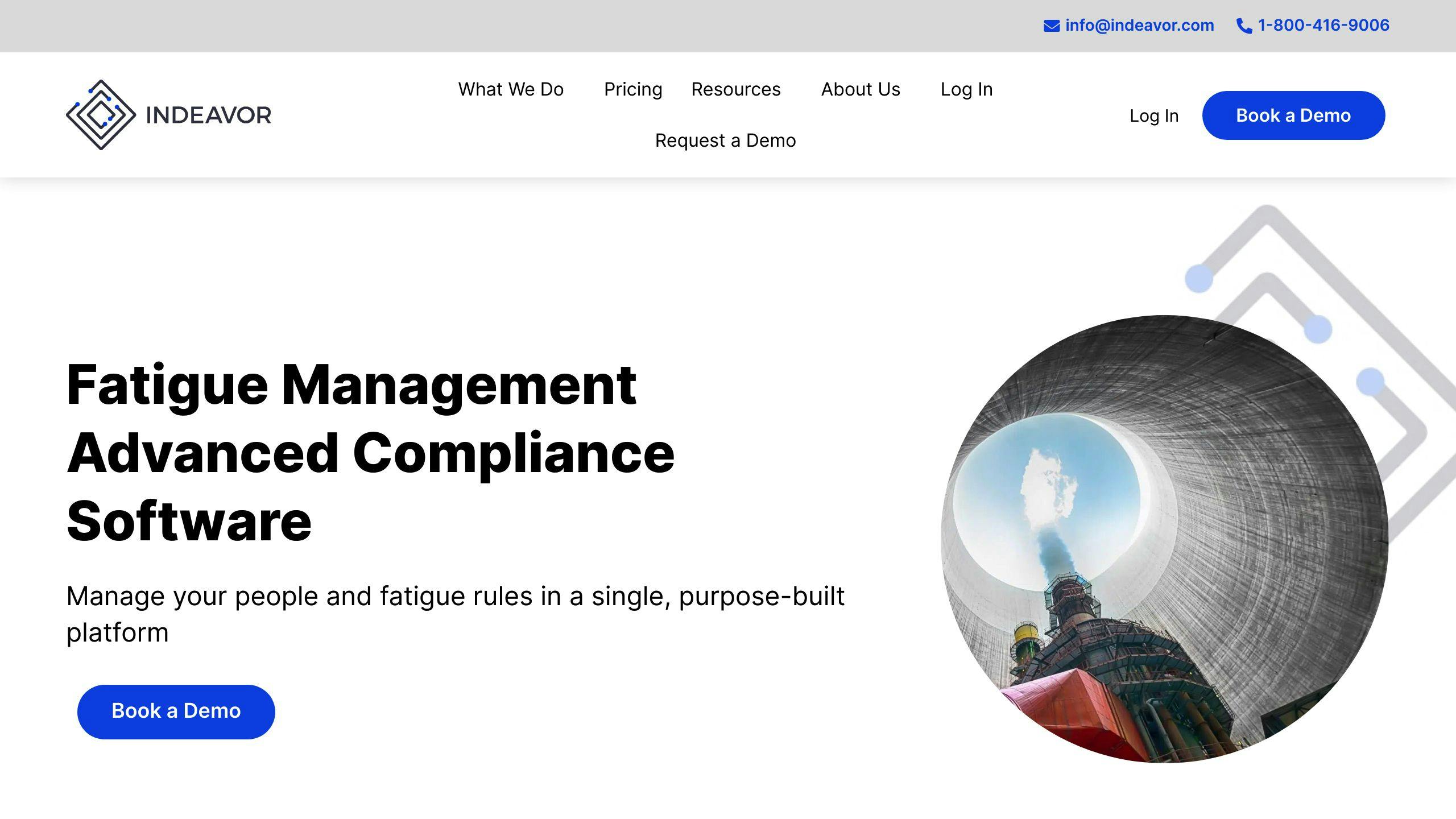
Indeavor's Fatigue Management module helps organizations manage fatigue risks and prioritize workforce well-being. It's useful for complex industrial enterprises where fatigue can impact safety, productivity, and operations.
Safety and Risk Reduction
The module automates schedule creation, ensuring compliance with industry rules and regulations. It alerts schedulers to potential fatigue risks, allowing informed decisions to mitigate these risks. The module also generates automated fatigue reports for regulatory bodies like the Nuclear Regulatory Commission (NRC), including waiver counts and violations.
Integration and Ease of Use
The Fatigue Management module integrates with existing human capital management and enterprise resource planning systems. It automates scheduling tasks, ensuring qualified employees are assigned to each position. With Indeavor's solution, organizations can streamline processes, reduce staff workload, and foster an engaged workforce.
Reporting and Analytics
The module provides detailed reports on fatigue risk levels, enabling data-driven decisions for safety and well-being. It also facilitates waiver form creation and centralized recordkeeping for fatigue-related documentation.
Compliance and Regulation
Indeavor's solution helps organizations comply with industry regulations, such as those set by the NRC. The Fatigue Management module ensures employee schedules adhere to rules on limiting work hours and days, minimizing the risk of fines and reputational damage. By automating schedule creation and fatigue risk analysis, organizations can demonstrate their commitment to workforce well-being and safety.
| Feature | Benefit |
|---|---|
| Automated Schedule Creation | Ensures compliance with regulations |
| Fatigue Risk Alerts | Enables informed decision-making |
| Regulatory Reporting | Generates required reports for bodies like NRC |
| System Integration | Streamlines processes and reduces staff workload |
| Detailed Analytics | Supports data-driven decisions for safety and well-being |
| Centralized Recordkeeping | Maintains fatigue-related documentation |
6. PRISM Fatigue Management Systems - Predictive Safety
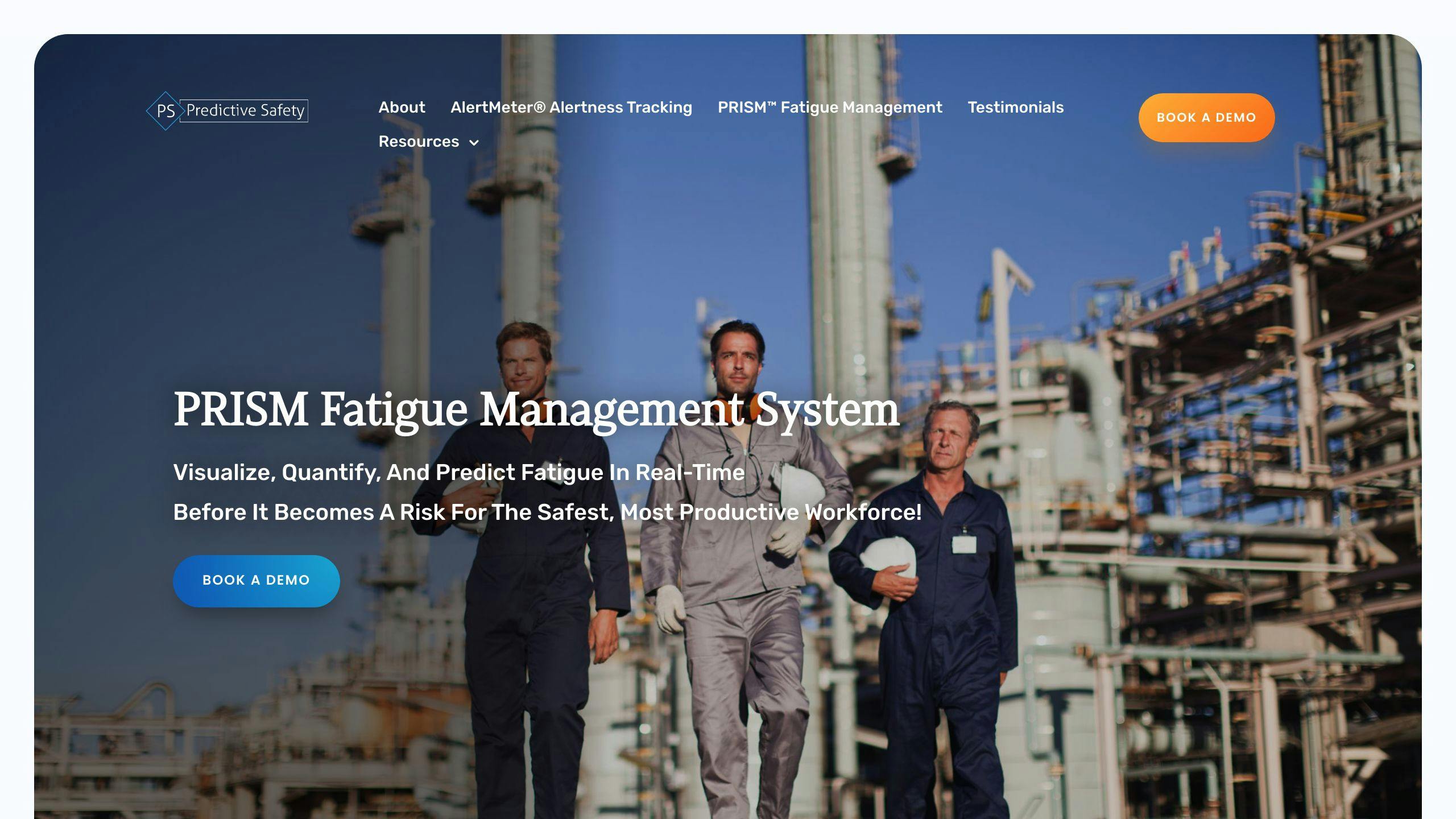
PRISM Fatigue Management Systems by Predictive Safety helps organizations manage fatigue risks and prioritize workforce well-being. This system is useful for industries where fatigue can impact safety, productivity, and operations.
Reducing Fatigue-Related Risks
PRISM's predictive algorithm enables informed shift scheduling, allowing supervisors and employees to monitor alertness levels and apply countermeasures to reduce or avoid fatigue-related impairment. A study at a large iron mine showed that monitoring and managing fatigue risk led to:
- 3% improvement in shift attendance
- 35% drop in incident rates per produced metric ton
Easy to Use and Integrate
PRISM provides a user-friendly interface for employees to clock in and out, and for supervisors to receive real-time notifications of at-risk employees. The system integrates with existing attendance systems, simplifying implementation and management.
Clear Reporting and Analytics
PRISM offers detailed reports on fatigue risk levels, enabling data-driven decisions for safety and well-being. The system provides a clear view of worked hours, helping identify problem areas and track the effectiveness of improvement initiatives.
| Feature | Benefit |
|---|---|
| Predictive Scheduling Algorithm | Informed shift scheduling to reduce fatigue risks |
| Real-time Notifications | Timely intervention for at-risk employees |
| Integration with Attendance Systems | Easy implementation and management |
| Detailed Reporting | Data-driven decisions for safety and well-being |
| Worked Hours Tracking | Identify problem areas and monitor improvements |
7. Fatigue Science: Readi | Predictive Fatigue Management Software
Readi by Fatigue Science is a fatigue management platform that provides insights into workforce fatigue levels - past, present, and future. This predictive software uses scientifically-validated models to quantify and forecast the effects of sleep disruption on reaction time and cognitive performance.
Proactive Safety and Risk Reduction
Readi's predictive approach allows supervisors to manage fatigue risks before they become critical. By anticipating individual fatigue levels, supervisors can implement targeted countermeasures, such as:
- Assigning additional rest breaks to specific operators at certain times
- Temporarily reassigning critical tasks to less fatigued operators in exceptional cases
This proactive approach contributes to a stronger safety culture based on real data and measurement.
User-Friendly and Integrated
Readi is a daily decision-making tool for shift supervisors and a system of record for operational fatigue data. It uses machine learning algorithms and the SAFTE biomathematical model to generate personalized fatigue predictions for every operator, delivered to supervisors' mobile devices at the start of each shift.
Clear Reporting and Analytics
| Feature | Benefit |
|---|---|
| Fatigue Predictions | Informed shift scheduling to reduce risks |
| Real-time Notifications | Timely intervention for at-risk employees |
| Attendance System Integration | Easy implementation and management |
| Detailed Reports | Data-driven decisions for safety and well-being |
| Worked Hours Tracking | Identify problem areas and monitor improvements |
Readi provides detailed reports on fatigue risk levels, enabling data-driven decisions for safety and well-being. The system offers a clear view of worked hours, helping identify problem areas and track the effectiveness of improvement initiatives.
Pros and Cons
Here's a summary of the advantages and drawbacks of each fatigue management software tool:
Workforce Management with SAFTE-FAST - Trapeze Group
| Pros | Cons |
|---|---|
| Comprehensive scheduling features | Steeper learning curve due to extensive functions |
| Detailed analytics and reporting | Higher cost compared to other tools |
UKG for Fatigue Management
| Pros | Cons |
|---|---|
| Easy-to-use interface and quick setup | Limited customization options |
| Strong reporting and analytics | Integration issues with some HR systems |
FAST Scheduling software for industry, military and... - Fatigue Science
| Pros | Cons |
|---|---|
| Science-based fatigue risk models | Higher cost due to advanced algorithms |
| Personalized fatigue predictions for workers | Requires significant data input for accuracy |
CIRCADIAN Software
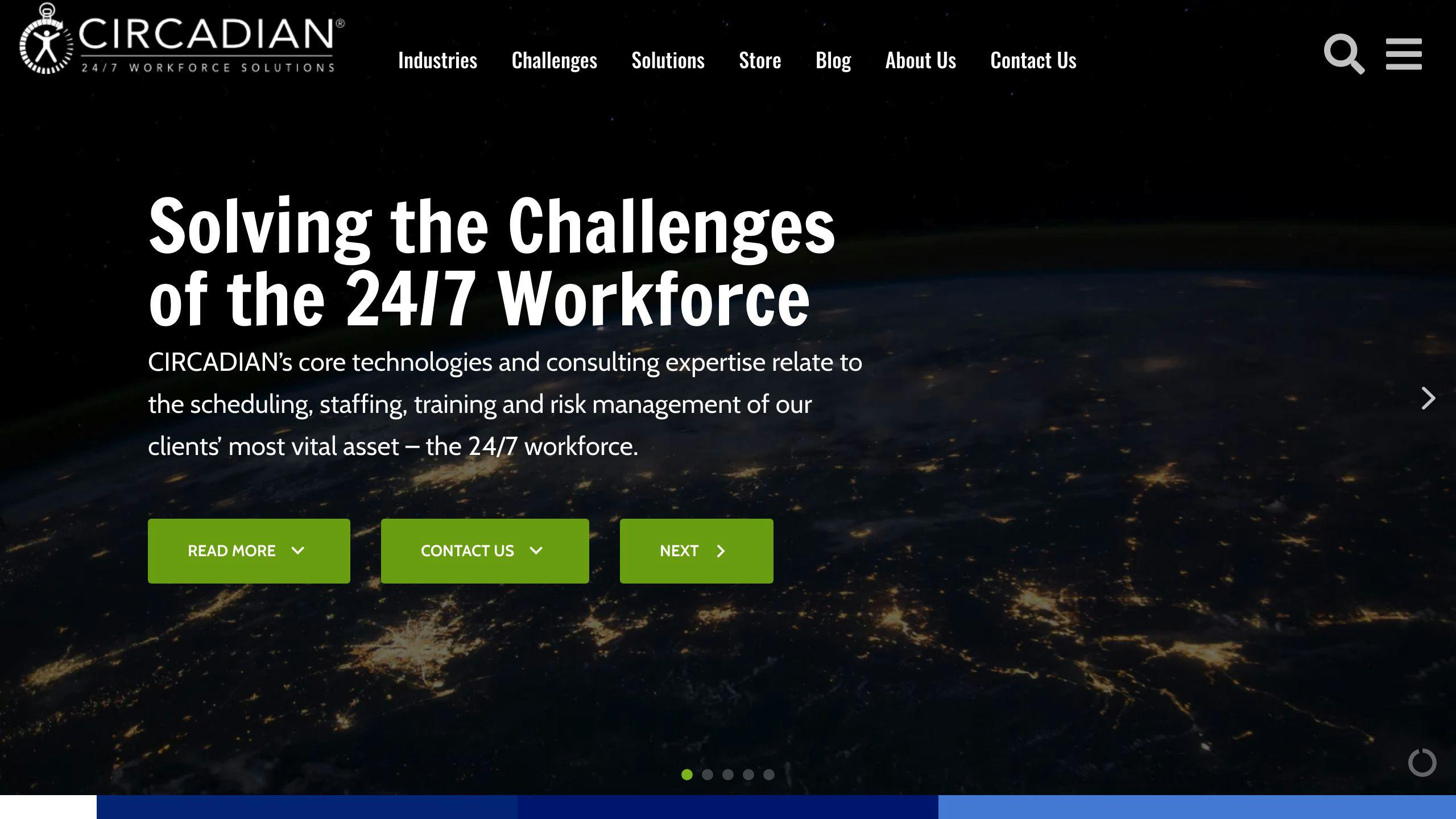
| Pros | Cons |
|---|---|
| Advanced fatigue risk management tools | Steeper learning curve due to complex algorithms |
| Integrates with various HR systems | Higher cost compared to other tools |
Fatigue Management - Employee Scheduling Tool - Indeavor
| Pros | Cons |
|---|---|
| User-friendly interface and fast implementation | Limited customization options |
| Robust reporting and analytics | Integration issues with some HR systems |
PRISM Fatigue Management Systems - Predictive Safety
| Pros | Cons |
|---|---|
| Advanced predictive analytics and reporting | Higher cost due to advanced algorithms |
| Personalized fatigue risk management for workers | Requires significant data input for accuracy |
Fatigue Science: Readi | Predictive Fatigue Management Software
| Pros | Cons |
|---|---|
| Science-based fatigue risk models | Higher cost due to advanced algorithms |
| Personalized fatigue predictions for workers | Requires significant data input for accuracy |
When selecting a fatigue management software, consider your organization's specific needs and priorities. Evaluate the pros and cons of each tool carefully to find the best fit for your workforce.
Final Thoughts
The Fatigue Management Software market is growing rapidly, driven by increased awareness of fatigue-related risks across various industries. The top 7 fatigue management software tools reviewed offer features to help organizations:
- Reduce fatigue-related incidents
- Improve productivity
- Promote employee safety and well-being
When choosing a fatigue management software, consider your organization's specific needs and priorities. Evaluate each tool's:
- Ease of use
- Customization options
- Reporting and analytics capabilities
- Integration with existing HR systems
Key Factors to Consider
| Factor | Importance |
|---|---|
| Ease of Use | A user-friendly interface simplifies implementation and adoption. |
| Customization | Ability to tailor the software to your organization's unique requirements. |
| Reporting & Analytics | Detailed insights enable data-driven decisions for safety and well-being. |
| Integration | Seamless integration with existing HR systems streamlines processes. |
FAQs
What technology is used to monitor worker fatigue?
Organizations use various technologies to detect and track employee fatigue levels:
- Brain Activity Sensors: These measure brain waves using electroencephalography (EEG) to identify fatigue patterns.
- Visual Monitoring: Cameras or computer vision systems look for signs of drowsiness, like frequent blinking or head nodding.
- Sleep and Activity Tracking: Data from wearable devices or apps is used to calculate fatigue risk based on sleep patterns and physical activity.
By monitoring fatigue through these methods, companies can take steps to reduce risks and improve workplace safety.
How does fatigue management software work?
Fatigue management software uses data from monitoring technologies to:
1. Identify Fatigue Risks
- Analyzes work schedules, shift patterns, and employee data
- Flags potential fatigue hazards based on factors like long hours, lack of rest, etc.
2. Provide Alerts and Notifications
- Sends real-time alerts when an employee is at high risk of fatigue
- Allows supervisors to intervene and take preventive measures
3. Generate Reports and Analytics
- Provides detailed reports on fatigue levels across the workforce
- Helps identify problem areas and track the effectiveness of fatigue management efforts
4. Optimize Scheduling
- Creates schedules that account for factors like shift length, rest periods, and workload
- Ensures compliance with regulations on work hours and rest periods
By using this software, organizations can proactively manage fatigue risks, improve safety, and promote employee well-being.
What are the benefits of using fatigue management software?
Using fatigue management software can offer several advantages:
| Benefit | Description |
|---|---|
| Improved Safety | Reduces the risk of fatigue-related incidents and accidents |
| Increased Productivity | Well-rested employees are more alert and efficient |
| Regulatory Compliance | Helps organizations follow rules on work hours and rest periods |
| Data-Driven Decisions | Provides insights for making informed decisions about fatigue management |
| Employee Well-being | Promotes a culture of safety and prioritizes worker health |
Overall, fatigue management software helps organizations take a proactive approach to managing fatigue risks, leading to a safer and more productive workplace.


